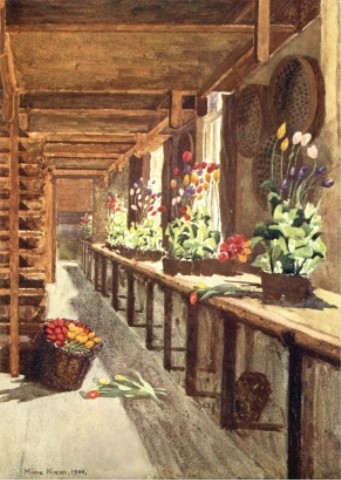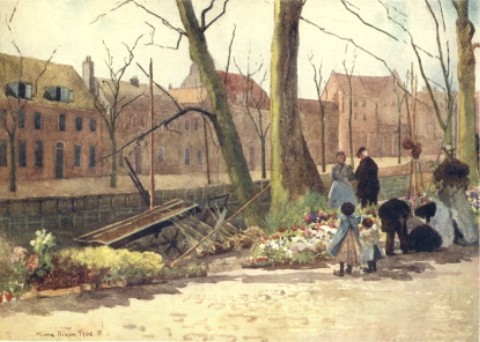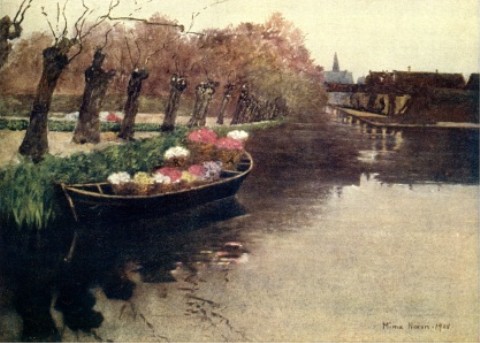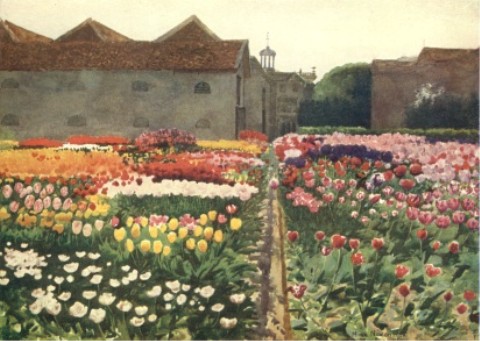|
CHAPTER VI
BULB BARNS, NAMES, AND GROWERS
THERE
is, without doubt, a certain charm in bulb barns; not perhaps quite the
charm of an old English barn, wherein there is ever a brown twilight
and never a straight line, and it is still possible to think of the
Good People coming to shelter on wet nights. Dutch barns, even the
least well kept of them, are too orderly for that. They are rather too
foursquare and deficient in the unexpected annexes and the mysterious
doors leading to nowhere and anywhere which are part of the true
fascination of barns. Nevertheless they have attractions; they are
warm-coloured, lofty, silent, and full of a pleasant dry smell; they
are essentially not people's houses though, especially at some seasons
of the year, they are houses of quiet, stored life.
Every
grower must have a barn; the big men, of course, more than one, the
number and size varying in proportion to the gardens. Those of the
little men are sometimes rather makeshift places, wherein, at other
times of the year, other things are kept and the true character of a
bulb barn somewhat lost. The true character is, pre-eminently,
orderliness; seen at perfection a bulb barn is, in its own way, as
typically Dutch as a hyacinth, it is the perfection of order and
system, and yet somehow cosily human too. Round the sides of the great
barns there are shelves with upturned edges; down the centre is a
stand, or two stands with an aisle between, if the barn is very large,
and these, too, are all shelves or trays, tray upon tray nearly to the
roof. Against the walls there are light ladders, easy to move when the
upper trays have to be reached. In the corners are heavier and longer
ladders leading to the stories above -- when there are any, as there
often are in the bigger barns. Here the bulbs are brought, sorted
according to kind and size and quality; here they accumulate from early
June, when the snowdrops and aconites are brought in, on through the
summer months till all are harvested and the barns are full, wonderful
quiet stores of waiting life.

Many of
the bulb barns have windows, herein also differing from the true
English barn, where the primitive fashion of lighting by the open door
still maintains, and is all that is necessary. In Holland it is
necessary to have at least some barns with windows, and windows that
open, for they have to be left open when the tulips are first brought
in, so that the bulbs may dry and get ready to be cleaned. The cleaning
of all bulbs, which consists in removing the old outer husk and
presenting the bulb dry and shining as we see it, is usually done by
women in a big barn not far from the grower's office. The work is not
hard, though the hours are long, and the wages, seeing that it is
unskilled labour, rather low. The principal objection to it is the skin
irritation that it causes, though one hopes that those daily employed
get hardened to that. One sees quite old women at the work,
grandmothers sitting on benches or upturned baskets, their brown
wrinkled faces bending over the bulbs, their long gold earrings,
possibly the only treasure left of some inherited store, dangling, And
beside them young girls, with round rosy cheeks and demure eyes, which
do not -- at least openly -- seek those of the men who pass to and fro
carrying the deep baskets full of bulbs. One seldom or never sees any
of the typical peasant head-dresses among the women who work at the
bulb-cleaning, presumably the workers are not drawn from the class who
still wear them. But one does see a beautiful neatness -- a general
impression of cleanness, of blue cotton, neat straight hair, and wooden
shoes; an appearance a good deal more neat and picturesque than the
average of poorer women-workers in England; unless, perhaps, one
excepts those who are employed in one branch of pottery-work, where the
necessary uniform is print sun-bonnets and overalls. There is no
flirting in the barn, practically no intercourse between the men and
women, the men simply carry in the basketsful of freshly-lifted bulbs
to be cleaned, and carry out those that are done. No doubt when work
ceases or dinner-hour comes some young people find each other out. It
would be clear waste and much to be regretted if they did not.
The men
employed in the bulb gardens work from about six in the morning till
seven at night in the summer; in the winter, of course, when the
daylight is short and the work less, not so long. The thing which
strikes one most about them is how much cleaner they are than any
English workers on the land. But it is not fair to ascribe this
entirely to native characteristics and ideals; the soil and conditions
of the bulb district are entirely different from those of any
agricultural part of England. It has been said of the men employed in
the bulb fields that they do not care about flowers, merely regarding
them as daily work and having no more aesthetic appreciation of them
than of turnips. Of course it may be so, but personally I rather doubt
it; although, as has been urged, they certainly do not grow flowers for
themselves. In the bulb district, one never sees blooming cottage
gardens as in England, but then land there is so valuable that
comparatively few people can afford to have gardens at all; and those
that do are both so poor and so thrifty that they cannot keep them for
pleasure only, but must turn their wee patch to the best food-producing
account. In the bulb district there is no waste land; no broad margins
-- " God's gardens," -- beside the road; no tangle of leeks and roses
beside a tumbling-down cottage door; no grass-grown marigold-studded
stretch of brickwork surrounding the common pump. There is no waste, no
weeds, no margins, and, alas ! but little beauty about the dwellings of
the work-people. Yet none the less it seems they love flowers, often
they are to be seen carrying them home, and seldom one passes houses
with no vase of them in the window in blooming time. And this, surely,
argues a real love of flowers, when one comes to think that they are in
themselves neither rare nor valuable here, many of the cut blooms
thrown away almost as much as the poppies in our English corn-fields.
Of course a certain number of the flowers are sold in Dutch towns -- as
in the towns of other countries, some few growers even may grow a small
quantity for that special purpose. But, again, in the purchasing of
them, the charge that the working-classes have no aesthetic love of
flowers would seem to be negated, for, though the prices of cut
flowers, considering the quantity grown, are relatively high, many of
the purchasers are workmen. One sees them on payday carrying home their
purchases with the same evident care and admiration that one sees
similarly bestowed by the better class of English mechanics and
workmen, when on Saturdays they carry home the bunches of wallflower
and violets that they buy in the streets.

There
are in Holland, besides the workmen and the great growers, others
concerned in the bulb industry, a whole lot of very small growers,
simple folk, who for the most part live in the numerous little villages
around Haarlem, Alkmaar, and Leyden. They own but one field, or perhaps
two, and combine with bulb-raising vegetable growing or cow-keeping.
They, with their families, do all the cultivation themselves, planting
and lifting the bulbs, the old folk or the children cleaning them,
working in the patriarchal co-operative way. These men may be seen in
Haarlem on Mondays in the bulb season (August to October); they come to
offer their bulbs to the exporters, who cannot for themselves grow
enough of some of the sorts in most demand, or who do not find it worth
their while to give up their land to producing the cheaper varieties.
Later on the bulbs themselves will come to Haarlem, by canal boat -- if
the canal is handy, or perhaps on the back of the man who raised them,
or perhaps brought by the good-wife, who may come barefoot along the
sandy road, only donning her shoes on the outskirts of the town. The
authorities of Haarlem will have no bare feet in their streets, their
sense of delicacy forbids; even the fishwives of Zandvoort, who walk
better than almost any other western women, have to put on the wooden
shoes they carry, in addition to their burden of fish, when they have
crossed the sand dunes and near the city.
But, of
course, not all the less-important growers are in such a small way;
some of them are substantial well-to-do men cultivating quite a
considerable quantity of land. Certain of them grow almost exclusively
for one or another special exporter, so that they seem to the
uninitiated to be his men, though in reality they are not at all. It is
these men who may sometimes be seen during the bulb season in the
exporter's office, or sitting with him in the veranda of his house,
talking of the weather and the condition of trade over a glass of
schiedam and a Dutch cigar, in the old-fashioned leisurely way that
still maintains in parts of Holland. Cheery, comfortable folk these,
speaking neither English, French, nor German; Dutch of the Dutch, and
not easily to be known by the foreigner.
In the
ordinary bulb barns there are two things to be guarded against, mice
and fire. Against the latter there is insurance, and one would think
there should not be much danger of it in those barns where there is a
rule forbidding the workmen to smoke while within. There are some
barns, however, where there is no such rule; where the master feels
that justice demands he should allow his men the liberty which he, with
the true Dutch love of tobacco, cannot do without himself. There is one
dear old man who usually smokes at meals and very often in bed, to the
danger of his bed-curtains; I do not think that he, even if cruel fate
compelled him to refrain himself, could find it in his heart to forbid
his workmen the well-loved pipe; certainly they all smoke everywhere in
his barns, but, so far as I have heard, he has never suffered loss by
fire.
Mice
can give much trouble to bulb growers; they are very partial to some
kinds of bulbs; they eat them in the ground unless they are driven out
by deep digging and laying the earth open to the frost beforehand. In
the barns they naturally assume that the grower has kindly put up a
good store for them. But by traps and eats and poison and wonderful
Dutch orderliness they are kept under. In a bulb barn at night one
hears few of the mysterious rustlings and patterings that make an
English barn suggestive of hid but active life.

There
is one other thing to be guarded against in some few barns, that is
frost. Not in the generality, of course, the ones where are accumulated
the ordinary bulbs of the trade; but in the ones where there are stored
things for spring planting, such as gladioli, begonias, hemerocallis,
dahlias, and other and choicer bulbs and tubers, the frost is a very
important consideration. Some barns are very carefully protected
against frost; some I know are carefully and systematically warmed
during the winter months, and never, winter and summer, is the range of
buildings empty. Standing in one of these, a curious thought comes; one
realises, as one looks at the crowded shelves and remembers those of
other barns beyond, that, could some cataclysm destroy the ornamental
flora of the world, but leave untouched this range of barns with their
contents (as Noah's ark in the Deluge), there would still be a good
start for repeopling the world with flowers. Representatives from all
quarters of the globe are to be found in those barns, bulbs proper, and
corms, and tubers, and all the variously named houses of stored plant
life. Besides the hyacinth and tulip of historic fame, and the humbler
crocus and snowdrop, there are calochortus of California, tigridias of
Mexico, begonias of Jamaica, tuberoses of Persia, gloxinias and
achimenes, cannas and crinums, amaryllis and arums -- flowers native to
all parts of the world, brought in the first instance by indefatigable
collectors, who often have faced real enough perils in their work --
the cold in Siberia, the heat in Africa, hunger and thirst, the ever
probable risk of robbery and violence of the Kurds in Central Asia, the
happy hunting-ground par excellence of collectors. No romance in the
bulb industry now? Why, it is full of romance! And not the smallest of
it, at least in the eyes of some, is the patient work, the ceaseless,
never-beaten perseverance and experiment by which the adventurously
brought plants are acclimatised to the chilly western countries, and
cultivated and varied to the manifold forms in which we find them now
grown in garden and green-house, and catalogued under various names.
The
names are something of a trouble to growers, at least some that I know.
"Why," asked one who, be it remembered, regarded his work with
seriousness and veneration, "Why will your English people call the
flowers by such foolish names? For an instance, ' Torch Lilies!' Where
is the torch ? Where the lily ? It is no lily, see the root, see the
flower. And for torch, or for ' flame flower,' as you sometimes also
call it, there is no resemblance; there is even none of the
waywardness, the unsteadiness or quivering of flames; these things, I
grant you, are in some flowers, as the pampas grass, but not in this,
it is a stiff, a formal flower. Yes, more like to a red-hot poker, as
also you call it. If you must have some other name than Kniphofia
(though I do not myself perceive that it is necessary or the one easier
than the other), if you must, I say, well then, it is perhaps best you
have 'red-hot poker,' it is at worst but childish and shows no mistake
in classification. But you would far sooner have it a lily, I know; all
things must be called ' lily' now, I cannot tell why -- Gladiolus, 'the
Sword Lily,' Vallota, 'the Scarborough Lily,' -- the Scarborough
Lily! One can almost as well have called it the Margate Potato!
"It is
the one thing I have against the English amateurs -- not all, of
course, but many -- they will not call a plant by its name, they will
have what they call a 'simple' or perhaps 'old-fashioned' name. But it
is ridiculous. If a flower has long had a simple name, as the primrose,
the foxglove, well and good; if it has had it in the common language so
long or longer than it has another of the botanists, why then one has
no quarrel with a man for using it. But if it is a flower of late days,
and there has come to it first the name of the botanist -- the man who
makes it some other 'simple' name, which is also quite erroneous, and
seems to class it as lily or as some other when it is almost as soon a
cabbage -- is nothing less than a child. Nevertheless for these we must
disfigure our catalogue with such names as Torch Lilies and the like."
And
certainly he and other growers do so "disfigure" their catalogues, for
a grower is a man of business. A rather curious mixture of the
commercial and the connoisseur; a practical man of business and a
gardener, but, above all things, one who loves his work. With the Dutch
grower, at least those of the older school, and I think the modern too,
work stands first. There is no hastening through with it, so as to
devote time and energies to sports and hobbies; sport does not play a
large part in the Dutch grower's life, and other hobbies are made
tributary to the one great interest. There was one old man who was at
heart an artist, in his far-off youth it is possible he cherished
dreams; but when necessity and circumstance made him a grower he put
the dreams away, though he kept his paint-box. On a Saturday sometimes,
locked safely in his office, he still took out the little box of
somewhat dried paints; he could no longer draw, his hands, steady
enough for any delicate operations of his work, had long lost their
skill. But still he sometimes carefully coloured the illustrations in
his catalogues, the real flower standing in a glass before him, and the
names of the paints he employed set down, so that he might more fitly
describe the true colours of the flower in the next catalogue compiled.
They were not always beautiful results he produced, but there was
something quaintly beautiful and withal pathetic about them and him.

Other
growers there are whose tastes are scientific, or perhaps for
photography or the microscope. These, too, are turned to account;
exquisite photographs of flowers illustrate the bulb lists; patient
examination of pollen and plant parasites, careful and systematic
experiments with soils and fertilisers, give help and enlightenment in
the growing and varying of the bulbs. Others there may be who have had
some thought of another profession before family circumstances gave
them to this life, but they are not the worse growers on that account.
They would not enlarge leisure to practise arms if their tastes were
military, or to read theology if their leaning was towards the
ministry; but they would be content to do their duty truly and
honestly, serve God and love their neighbour, and give to the work they
had undertaken the whole of themselves.
This,
then, above all things strikes one, a grower is a man steeped in his
work; he lives in the midst of it, he rises with it, and goes to bed
with it. On his few holidays he goes to see the achievements of others
in it, or, better still, the working of nature. He goes to see other
things too, no doubt, he has other interests -- pictures, or music, or
literature, or languages -- he is no narrow uncultivated man; but his
work stands first, a long, long way first, he and it are curiously and
indissolubly one. So for this reason I say at the last, as I said at
the first, those who would see and know the bulb gardens of Holland
should also know the men who for generations have grown the bulbs, and
loved and understood them.
|

